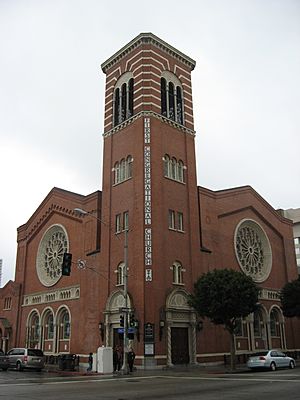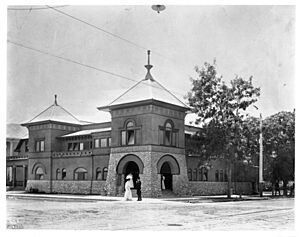First Congregational Church (Long Beach, California) facts for kids
Quick facts for kids First Congregational Church |
|
|---|---|

First Congregational Church, February 2008
|
|
| 33°46′13″N 118°11′43″W / 33.77028°N 118.19528°W | |
| Location | 241 Cedar Ave., Long Beach, California |
| Country | United States |
| Denomination | United Church of Christ |
| Churchmanship | Congregationalist |
| Website | www.firstchurchlb.org |
| History | |
| Status | Church |
| Founded | 1888 |
| Dedicated | December 1914 |
| Architecture | |
| Functional status | Active |
| Architect(s) | H. M. Patterson |
| Architectural type | Italian Romanesque Revival |
| Completed | 1914 |
| Construction cost | $210,000 |
The First Congregational Church is a special church in Long Beach, California. It belongs to the United Church of Christ. This church is famous for its beautiful red brick building, which was built way back in 1914. The building has a unique style called Italian Romanesque Revival. It's so important that it's been named a Long Beach Historic Landmark. It was also added to the National Register of Historic Places in 2012, meaning it's a nationally recognized historic place!
Contents
Building the Church
The First Congregational Church started in 1888. The building you see today was finished in 1914. It cost about $210,000 to build, which was a lot of money back then!
Who Helped Build It?
A man named Jotham Bixby Sr. was a big help. People called him the "Father of Long Beach." He gave $25,000, which was the largest donation for the church's construction.
Church Design and Features
The church was designed by an architect named H.M. Patterson from Los Angeles. He used a style called Romanesque, which looks like old European churches. The building is made of red bricks with white decorations.
The main room, called the auditorium, was huge! It could fit 1,500 people. The roof was 55 feet high, making it feel like a grand cathedral. The church also has amazing stained-glass windows. One newspaper said they were "among the finest to be seen in the West." There are three large round windows, called rose windows, and six other beautiful picture windows. The middle window is known as the "Light of the World."
Church History
The church building officially opened in December 1914. More than 2,000 people came to the dedication! At the time, it was the biggest church in Southern California.
Growing Community
In 1924, a three-story building was added for education and events. By 1927, the church had grown a lot. It became the fifth largest Congregational church in the United States, with 1,700 members.
Earthquake and Repairs
In 1933, a big earthquake hit Long Beach. The church was damaged and had to close for several months for repairs. Rev. Henry Kendall Booth was the pastor during this time, serving from 1909 until he passed away in 1942.
On the Big Screen
The church building even appeared in a movie! It was featured in the 2007 film License to Wed.
Helping the Community
The First Congregational Church is known for helping people. It has a long history of supporting those in need. This includes programs to help people who are poor, do not have homes, or have disabilities.
Welcoming All People
In 1992, the church made a public statement saying that it welcomes all people, including those who are gay, lesbian, bisexual, and transgender, to be members, work there, and be leaders. By 2005, a large part of the church's members came from the LGBTQ+ community.
Standing Up for Others
In 2007, the church's senior pastor, Jerald Stinson, made news. He said he would not stop homeless people from sleeping on the church steps and grounds, even if the city told him to. He believed that helping these people was an important part of their faith.
See also


